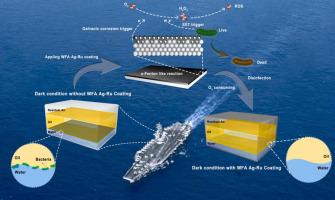Journal of Hazardous Materials ( IF 12.2 ) Pub Date : 2022-08-08 , DOI: 10.1016/j.jhazmat.2022.129730 Jizheng Yao 1 , Tao Jiang 1 , Yucheng Ji 2 , Biwen Annie An 3 , Andrea Koerdt 3 , Zhongqi Cai 1 , Chaofang Dong 2 , Yan Ge 1 , Zhenhui Qi 1

|
Water is generally considered to be an undesirable substance in fuel system, which may lead to microbial contamination. The antibacterial strategies that can turn water into things of value with high disinfection efficacy have been urgently needed for fuel system. Here, we reveal a water-fueled autocatalytic bactericidal pathway comprised by bi-metal micro-electrode system, which can spontaneously produce reactive oxygen species (mainly H2O2 and O2•–) by the electron Fenton-like reaction in water medium without external energy., The respiratory chain component of bacteria and the galvanic corrosion on the coated metals were two electron sources in the system. The specific model of Ag-Ru water-fueled autocatalytic (WFA) microelectrode particles presents extremely high disinfection efficiency (>99.9999%) in less than one hour for three aerobic bacteria (Escherichia coli, Pseudomonas aeruginosa and Bacillus subtilis) in LB media and high disinfection efficiency for the anaerobic bacteria (Desulfovibrio alaskensis) in Postgate E media without natural light irradiation. Overall, the novel WFA Ag-Ru antibacterial material explored in this study has a high potential for sterilizing applications in fuel system and this work provides the potential for the development of non-chemical and water-based antibacterial materials, such as WFA Ag-Ru antibacterial coating on stainless steel.
中文翻译:

基于由电偶腐蚀和细胞外电子转移触发的类 e-Fenton 反应的水燃料自催化杀菌途径
水通常被认为是燃料系统中的不良物质,它可能导致微生物污染。燃料系统迫切需要能够将水转化为具有高消毒功效的有价值物品的抗菌策略。在这里,我们揭示了一种由双金属微电极系统组成的水燃料自催化杀菌途径,该途径可以自发产生活性氧(主要是H 2 O 2和O 2 •–) 在没有外加能量的情况下,在水介质中发生电子类芬顿反应,细菌的呼吸链成分和涂层金属的电偶腐蚀是系统中的两个电子源。特定模型的 Ag-Ru 水燃料自催化 (WFA) 微电极颗粒在 LB 培养基中对三种需氧细菌(大肠杆菌、铜绿假单胞菌和枯草芽孢杆菌)在不到 1 小时的时间内呈现出极高的消毒效率(>99.9999%)和高对厌氧菌(Desulfovibrio alaskensis)的消毒效率) 在没有自然光照射的 Postgate E 介质中。总体而言,本研究中探索的新型 WFA Ag-Ru 抗菌材料在燃料系统的灭菌应用方面具有很高的潜力,这项工作为开发 WFA Ag-Ru 等非化学和水基抗菌材料提供了潜力不锈钢上的抗菌涂层。











































 京公网安备 11010802027423号
京公网安备 11010802027423号